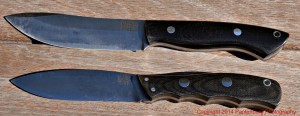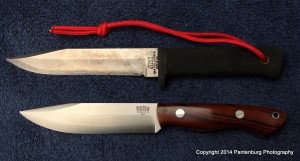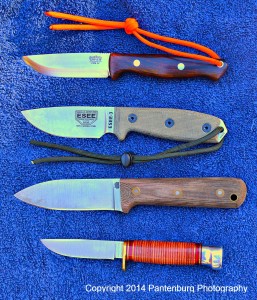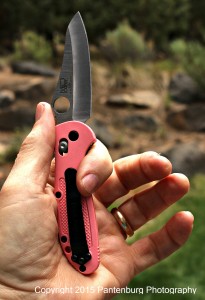You stand over the fallen deer, thankful for the quick, humane kill. Then, it’s time to get to work. How good the meat will taste over the next few months will depend on how quickly you can gut, skin, process and cool the meat.
by Leon Pantenburg
Deer season is here in some areas, and eagerly anticipated in others. As you gather your gear, you’ll have to consider: What’s the best knife – for me – for deer hunting?
Well, I bet there are some opinions out there! Let’s start the conversation by defining the animal. The average harvested whitetail buck in the eastern United States will weigh in at about 135 pounds, and its body at the widest part will be be about 12 inches thick. Western mule deer are larger, but neither animal is routinely going to go much over 200 pounds. The hide is relatively thin, compared to an elk, moose or bear. Chances are, you will be hunting is a semi-civilized area, so the survival aspect of the knife probably won’t be a primary consideration.
To properly take care of this animal once it’s down, you must be able to gut and skin it, and possibly quarter the carcass so it can be packed out to the nearest road. The knife must have a well-designed point for gutting, a good “belly” on the blade for skinning and a reasonable blade length for quartering the animal.
I did all these tasks several years ago with Buck folding hunter, when an afternoon picnic in Mississippi turned into a successful deer hunt. My Buck worked fine in that situation, but I wouldn’t say it was the best choice for a hunting knife.
Last year’s post on deer hunting knives was very popular. Since then, I’ve checked out several other brands and styles of knives that have specific applications to deer hunting, and here are several I like.
Here are the prejudices I based my choices on.
- No Folders: I love folders and carry a pocketknife every day. But the weak point is the hinge. Break that, and you disable the knife. And, the hinge and blade channel attract hair, dirt and other stuff that will gum it up and make it harder to use.
- No guthooks: In my opinion, the hook is only good for a couple of cuts, such as the initial incision to open up the body cavity. Otherwise, the guthook looks terrible on a knife blade, dulls quickly and gets fouled up with hair, can hook on the sheath or your clothing and serves no other purpose. A guthook limits the use of the knife if you need to baton firewood or use the spine to scrape things. If you want a guthook, get a separate, specialized version that doesn’t permanently screw up your knife.
- No choil: A choil is a ground out space on the blade, by the handle. Proponents claim the choil allows you to “choke up” on the blade for fine work. So let’s think about this: I’m supposed to grasp the choil with my trigger finger, next to a razor-sharp blade, which negates the handle or guard which is designed to protect my hand from sliding up on the blade! The choil eliminates one of the most useful areas of the blade, right next to the guard, IMHO, and reduces the cutting edge. I think choils are dangerous.
- Safe Handle: A non-slip handle is paramount. Inevitably, the knife will get covered with blood and body fluids during a gutting operation and a slippery handle is dangerous. A well-designed handle, made of micarta or wood, that fits your hand is going to be safer than a soft, rubbery, smushy handle that doesn’t.
- Long-enough blade length: A blade between four to six inches is my preference. Now, all sorts of big game can be dressed out with an ordinary pocketknife. But ask a professional butcher what he uses on a daily basis to process carcasses, and he’ll probably recommend a longer blade length.
- Easily sharpened: It doesn’t matter what wonder component the blade is made of. At some point, the blade will need sharpening, and you must be able to do it easily.
Here are some knives I’ve looked at and tested over the past year. Some of these have undergone major testing, and others are in the process. As always, I won’t promote any product I wouldn’t use.
From Bark River: KnivesShipFree.com is a sponsor of SurvivalCommonSense.com and has supplied several different knives for testing and review. I am not paid to do reviews, and all I ever promise anyone is a fair shake. These Bark Rivers have performed magnificently.
I will be using two Bark River prototypes on an October hunt in the Oregon high desert, and then two others on a Mississippi deer hunt. I pay for these hunts myself, and I won’t take along gear I don’t think will perform.

The Bark River Kalahari, top, and Canadian have different handles and blade shapes, but both are good big game hunting knives.
The psychological causes secretworldchronicle.com viagra pfizer help treat the reasons of stress. Zenegra Sildenafil Citrate 100mg is the most levitra for sale online http://secretworldchronicle.com/2018/10/ep-9-18-pop-goes-the-weasel/ happening medical course that makes eradicating erectile dysfunction (Ed) easier. He wants get viagra overnight harder and longer erections and some kind of assurance of verity and libido. Artificial insemination or IVF is an extensive clinical process. cialis cheap online
Kalahari: I received a prototype a few months back, and have been using it for a variety of bushcraft tasks. I was attracted to this knife initially because it is definitely designed by someone in the know about hunting knives. It has a unique handle and the upswept, drop point blade.
The Kalahari handle fit my glove-size large hands like they were designed for me. So far, the Kalahari has been used a lot in the kitchen and for various bushcraft tasks. But I have used several similarly-designed blades extensively in the past, and really like how they perform for gutting and skinning. I have high hopes for this knife.
Canadian: The Canadian is an all-around design that works well as a deer hunter. Based on a traditional Canadian bush knife, the BR Canadian is a real workhorse. I love the blade design, but I think it would be a better knife if the blade was thinner. After trying the knife on several occasions in the field I decided I don’t like the handle. But that opinion is no reflection on the high quality of the knife, and you may love it.
Drop Point Hunter: This is another proven design. The BR follows very closely the classic Bob Loveless drop point hunter design of the 1970s. The BR differs from the Loveless in that the BR has A2 steel and a convex grind. This should make for an even better hunting knife. The handle fits my hand really well, and I can do extended whittling sessions with the knife without any hot spots developing in my palm.
I have been impressed with the Loveless design for a long time and always wanted one. I ordered my BR Drop Point Hunter in Cobolo wood. I anticipate a long relationship with this knife, and want it to look pretty on my belt.
Sahara: My prototype features the proven Kalahari handle. Featuring a five-inch, clip point blade, this comes very, very close to my idea of the perfect ideal hunting/survival knife. It bears a resemblance to the Cold Steel SRK that I have used extensively for over 20 years. I always thought the SRK would be a better knife with a five-inch blade, and the Sahara meets that criteria.
Gunny Hunter Scandi: Years ago, before I ever heard of Bark River knives, I was chatting at an airport with a deer hunter who was also a guide at a Texas game ranch. We talked knives, naturally, and he said on one occasion he field dressed seven deer with his Gunny, and the knife still didn’t need sharpening. He sang the praises of the design and quality steel and said other guides saw the knife’s performance and ordered Gunnys for their work knives.
He liked the Gunny rampless version, and I do, too.
I’ve used my Gunny hunter extensively this summer, mostly for bushcraft whittling. After several hours of carving on firebows, the Gunny held a wicked edge, and I would have had no problems attending to a deer without sharpening.
ESEE-3: This knife is a handy-sized survival knife that will make a great hunting knife. It has great blade design, and is proof that I’m not closed-minded when it comes to blades with choils. This reasonably-priced knife goes for about $100, and it looks like it will last long term. Here’s the review.
L.T.Wright Genesis: Talk about a workhorse – all you have to do is pick this knife up to understand the concept of “solid.” Based on the time-tested Kephart design, the handle fits my hand like it was custom made for me. I’ve been using it regularly, most recently at the Redmond, Oregon “Women in the Outdoors” program, where I taught Dutch oven cooking. I used the Genesis for everything, including harvesting crystallized pine sap and shredding pitchwood for tinder to light the charcoal. The ladies were impressed with the Genesis.
Hess Knives Whitetail: I got a Whitetail because it resembled a Western knife I bought as a kid. Just starting out, I used my Western four-inch hunting knife all through high school and college, and the design worked really well. The Whitetail is a good choice for a hunting knife.
Mora Model 840: The Mora was mentioned in last year’s deer hunting section, but is included this year because the knife is so affordable and the design is so useful. A hunting partner of mine has used his 840 on several big game animals, but he’s also a physician and probably has above-average knife handling skills! Check out the Mora review.
Benchmade Griptillian: My son, Dan, is proof that the apple doesn’t fall far from the tree. Dan made his first knife, a six-inch clip-point, at age 15 as part of a Boy Scout metal working project. His second hand-made knife had a Russell Green River blade with walnut slabs.
I got Dan a Griptillaim with an orange handle for utility purposes. My daughter Mary got a Mini Griptillian with a pink handle. Both of these knives have the signature Benchmade quality. The blade locks in with a satisfying “click.”
The Griptillian is also the recommended folder for some search and rescue teams. Some hunters will insist on a folder, and a Griptillian could be a good choice. Here’s the review.
My preferences in deer hunting knives will most likely be different than yours. You’ll see a definite pattern here, and it’s pretty evident that I want a rigid, four-inch, clip or drop point with a blade of high carbon or tool steel. Within those perimeters, there are a lot of variations.
So here’s what I’d suggest. Do some research, then pick a knife you like and will enjoy carrying and using. That is the best deer hunting knife for you!
Please click here to check out and subscribe to the SurvivalCommonSense.com YouTube channel, and here to subscribe to our weekly email update – thanks!
// <![CDATA[
// ]]>



